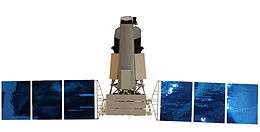Spektr-RG
 Spektr-RG | |
| Mission type | X-ray astronomy[1] |
|---|---|
| Operator |
Russian Space Research Institute European Space Agency, Max Planck Institute, University of Leicester |
| Website |
hea |
| Spacecraft properties | |
| Bus | Navigator[2] |
| Manufacturer | NPO Lavochkin |
| Start of mission | |
| Launch date | 25 September 2017[1] |
| Rocket | Zenit-3F[1] |
| Launch site | Baikonur 45/1 |
| Orbital parameters | |
| Reference system | Geocentric |
| Regime | Low Earth |
| Main telescope | |
| Type | eROSITA: Wolter |
| Wavelengths | X-ray |
| Instruments | |
| eROSITA, Lobster, ART-XC | |
Spektr-RG (Russian for Spectrum + Röntgen + Gamma; also called Spectrum-X-Gamma, SRG, SXG) is an international high-energy astrophysics observatory, which is being built under the leadership of the Russian Space Research Institute (IKI). Spektr-RG instrumentation includes 5 telescopes spanning the energy range from the far ultraviolet to the hard X-ray, plus an all-sky monitor. As of April 2016 it is planned to launch on 25 September 2017.[1]
Development of an early version with the same name was cancelled in 2002.[3] The second Spektr-RG is intended to study interplanetary magnetic field, galaxies, black holes.[4]
Spacecraft
The Spektr-RG programme was revived in 2005[5] and the spacecraft was in final stages of assembly during 2016. As of mid-2016 and after repeated slippage in the schedule, instrument launch is scheduled for late-2017.[1] The observatory is intended to study the interplanetary magnetic field, galaxies and black holes.[4]
Instruments
| Instrument | Organisation | Description |
|---|---|---|
| eROSITA (Extended Roentgen Survey with an Imaging Telescope Array) |
Max Planck Institute for Extraterrestrial Physics | Wolter telescopes |
| ART-XC | IKI/VNIIEF | Coded-mask telescopes |
Earlier proposal
.png)
Development of an early version of Spektr-RG was started in mid-1990s and was cancelled in 2002.[3] Initial launch date was set to 1995,[6] but later postponed as far as 2008, until it was finally cancelled in 2002.[3] However, some of the instruments have been completed, e.g., an X-ray telescope by Leicester University (JET-X)[7] and an ultraviolet telescope by Tel-Aviv University (TAUVEX).
The satellite would have been launched into a 51.5 degree orbit with an apogee of 200,000 kilometres (120,000 mi) and a period of four days, by a Proton-K rocket with a Blok DM-2 upper stage.
| Instrument | Organisation | Description |
|---|---|---|
| JET-X[8] | Two co-aligned 4.4 m-long X-ray telescopes | |
| TAUVEX | Ultraviolet telescope | |
| EUVITA | Ultraviolet telescope | |
| MART | X-ray telescope with coded-aperture instruments | |
| LEPC/HEPC | gaseous position-sensitive proportional counters | |
| SIXA | two solid-state Si(Li) detectors | |
| SXRP | stellar X-ray polarimeter | |
| MOXE | X-ray all-sky monitor | |
| DIOGENE | Spectrometer for measuring gamma-ray bursts | |
| SPIN | Spectrometer for measuring gamma-ray bursts | |
| Gaseous scintillation proportional counter | ||
| SODART[9] | High-throughput multi-mirror X-ray twin telescope of 8m focal length with changeable detectors on slides for energies between 0.1 and 20 keV | |
| Bragg spectrometer |
References
- 1 2 3 4 5 Zak, Anatoly (16 April 2016). "Spektr-RG to expand horizons of X-ray astronomy". Russian Space Web. Retrieved 16 September 2016.
- ↑ Gunter Dirk Krebs. "Spektr-RG (SXG)". Retrieved 2011-02-04.
- 1 2 3 Harland, David M.; Harvey, Brian (2007), Space Exploration 2008, シュプリンガー・ジャパン株式会社, p. 96, ISBN 978-0-387-71667-1, retrieved 2011-02-04
- 1 2 "Russia to Restart Science in Space". Russian Federal Space Agency. 2010-08-12. Retrieved 2011-02-04.
- ↑ "Spectrum-RG/eRosita/Lobster mission definition document". Russian Space Research Institute. 2005-10-30. Retrieved 2011-02-04.
- ↑ "Spectrum-X-Gamma". DTU Space. 2000-08-04. Retrieved 2011-02-04.
- ↑ "Leicester's role in Russian satellite programme revealed as UK's largest telescope goes to Science Museum". DTU Space. 2009-06-17. Retrieved 2011-02-04.
- ↑
- ↑
See also
- Neutron Star Interior Composition Explorer (NICER, another X-ray obs. of the 2010s)
- ROSAT (all-sky X-ray obs. from the 1990s)
- Chandra X-ray Observatory (X-ray telescope from 1990s (narrow but higher resolution FOV)
- Granat (old Soviet X-ray obs., 1980s)
External links
- Spectrum-X-Gamma on the internet.
- New X-Ray Telescopes Search for Galaxy Clusters and Massive Black Holes
